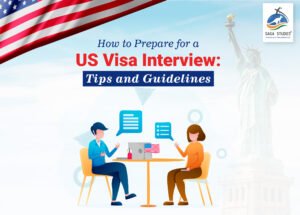Introduction
Obtaining a US student visa is crucial for anyone aspiring to study in the United States. This visa not only allows you to pursue your academic dreams but also provides you with an opportunity to experience the rich cultural diversity of the country.
In this blog, we will guide you through the entire application process for a US student visa, from understanding the different types available to meeting the eligibility criteria and gathering the necessary documents. By following this guide, you will be well-prepared to navigate the application process and achieve your goal of studying in US.
F1 Student Visa USA
When applying for a US student visa, it’s important to understand the different types available to choose the one that best fits your academic or vocational plans. The US F-1 student visa is the most common and is specifically for academic students enrolled in a full-time program at an SEVP-approved school.
This visa is for those pursuing academic courses and degrees from accredited institutions. One of the advantages of the US student visa F1 is that it allows part-time and on-campus employment for up to 20 hours per week, providing opportunities to gain valuable experience and supplement your finances.
To obtain an F-1 visa, you must provide proof of financial support to cover tuition and living expenses during your stay. The visa is valid for up to 5 years, with an additional 60 days to stay in the US after completing your program. The SEVIS fee for the F-1 visa is $350 (approximately INR 29,000), and the total visa fees, including SEVIS and application fees ($185), amount to $535 (approximately INR 43,870).
Eligibility Criteria for USA Student Visa
To secure a US student visa from India, applicants must meet several eligibility criteria, transitioning through various academic, financial, and health requirements.
- Academic Requirements
Firstly, applicants need to meet specific academic qualifications and prerequisites. This includes:
- Acceptance at a U.S. Institution: Applicants must receive an admission offer from a U.S.-accredited educational institution, such as a university, college, or vocational school.
- Valid I-20 Form: After acceptance, the institution will issue a Form I-20, a Certificate of Eligibility for Non-immigrant Student Status. This document is crucial for the visa application process.
- Proficiency in English: Most U.S. institutions require proof of English language proficiency, typically demonstrated through standardized tests like TOEFL or IELTS.
- Academic Qualifications: Students should have the necessary academic qualifications or prerequisites for their chosen program, including high school diplomas, undergraduate degrees, or relevant certifications.
- Financial Requirements
Next, proving the ability to cover the expenses associated with studying in the USA is essential. Applicants must provide financial documentation and evidence, which can include:
- Bank Statements: Demonstrating sufficient funds in a bank account to cover tuition, living expenses, and other educational costs.
- Affidavit of Support: Some students may require a sponsor, such as a family member or guardian, to provide a formal affidavit of support confirming their commitment to covering the student’s expenses.
- Scholarships and Financial Aid: If applicable, students should provide proof of scholarships or financial aid they have received to support their education.
- Health and Insurance Requirements
Moreover, health and medical insurance requirements are crucial for international students. The USA often mandates that students have adequate health coverage, including:
- Immunization Records: Some institutions may request proof of immunizations or vaccinations, especially for transmittable diseases to protect public health.
- Health Examination: Visa applicants must undergo a medical examination to ensure they are healthy before entering the country.
- Criminal Record Check
Finally, while a criminal record check is not a standard requirement for obtaining a U.S. student visa, some programs or institutions may request background checks for specific purposes, such as internships or research positions. Being transparent about any criminal history is essential, as non-disclosure can lead to visa denials or other legal issues.
By understanding and meeting these eligibility criteria, you can effectively navigate the application process for a US student visa from India.
Application Process
Navigating the application process for a US student visa involves several key steps. You can ensure a smooth and successful application by following these steps methodically.
Step 1: Admission to a U.S. Institution
First, apply and secure admission to a SEVP-certified U.S. educational institution for F1 and M1 visas or an approved exchange program for J1 visas. Once accepted, make sure to pay the admission deposit fee.
Step 2: Pay SEVIS Fee
Next, pay the SEVIS (Student and Exchange Visitor Information System) fee, which supports program administration and maintenance. After payment, you will receive a receipt confirming your payment.
Step 3: Complete the DS-160 Form
Then, fill out the DS-160 form online. Obtain the confirmation receipt with the barcode needed for your visa interview.
Step 4: Pay US Student Visa Application Fees
Proceed to pay the non-refundable US student visa application fee through the designated bank or online payment system.
Step 5: Schedule Visa Appointment
Create an account on the U.S. Visa Information and Appointment Services website. After paying the visa application fee, schedule your visa interview appointment at the nearest U.S. embassy or consulate.
Step 6: Gather Required Documents
- A passport valid for at least six months beyond your intended stay
- DS-160 confirmation page
- Form I-20
- SEVIS fee payment receipt
- Proof of English proficiency (IELTS or TOEFL scores)
- Financial documentation showing funds equal to or above the total cost of education as indicated in your I-20 form
- Your university may inform you of any additional requirements before your application.
Step 7: Attend Visa Interview
A few days before your interview, provide your biometric data. Attend the visa interview at the U.S. embassy or consulate, ready to discuss your educational plans, financial situation, and ties to your home country.
Step 8: Visa Decision
After the interview, your visa application will be processed. You will either be granted a visa or provided with a reason for denial.
Step 9: Receive Visa and Prepare for Travel
If your visa is approved, your passport will be stamped with the U.S. visa. Verify that all visa information is accurate. Then, make travel arrangements and prepare for your journey to the United States.
Step 10: Entry to the United States
Upon arrival in the U.S., you will go through Customs and Border Protection (CBP) processing at the port of entry. Have your passport, visa, Form I-20 or DS-2019, and other supporting documents ready for inspection.
By following these steps, you can confidently navigate the US student visa application process and embark on your educational journey in the United States.
Conclusion
Applying for a US student visa may seem complicated, but you can successfully navigate the process with the right information and preparation. Remember to follow each step carefully, meet all the requirements, and gather all the necessary documents.
For personalized guidance and assistance, feel free to contact the expert education counsellors at Saga Studies. They can help you every step of the way, ensuring your application is complete and accurate. Good luck with your journey to study in USA.




